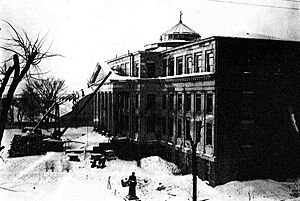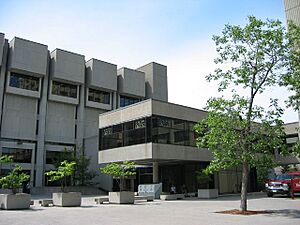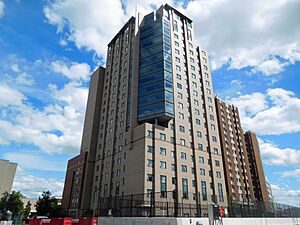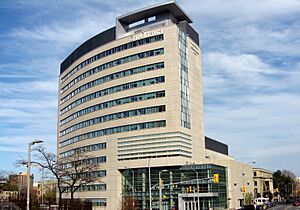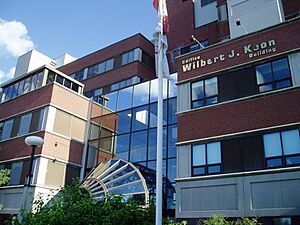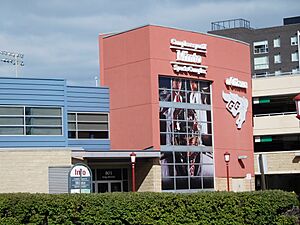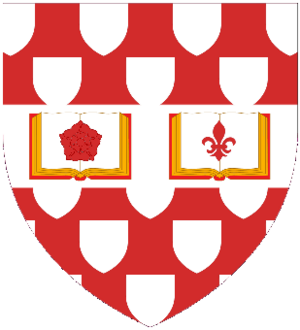University of Ottawa facts for kids
|
Université d'Ottawa
|
|||
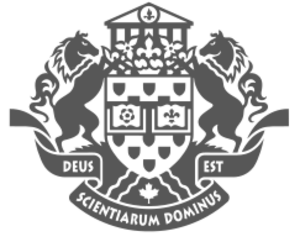
|
|||
| Latin: Universitas Ottaviensis | |||
|
Former names
|
College of Bytown (1848–1861) College of Ottawa (1861–1866) |
||
|---|---|---|---|
| Motto | Deus scientiarum Dominus est (Latin) | ||
|
Motto in English
|
God is the master of the sciences | ||
| Type | Public university | ||
| Established | 1848 | ||
|
Academic affiliations
|
ACU, ACUFC, CARL, COU, CUSID, Fields Institute, IAU, Universities Canada, U15 | ||
| Endowment | CA$333.880 million (2023) | ||
| Budget | CA$1.625 billion (2024) | ||
| Chancellor | Claudette Commanda | ||
| President | Jacques Frémont | ||
| Provost | Jacques Beauvais | ||
|
Academic staff
|
2,911 | ||
|
Administrative staff
|
2,839 | ||
| Students | 48,800 | ||
| Undergraduates | 39,770 | ||
| Postgraduates | 8,600 | ||
| Location |
,
,
Canada
45°25′20″N 75°40′57″W / 45.4222°N 75.6824°W |
||
| Campus | Urban, 42.5 hectares (105 acres) | ||
| Language | English and French | ||
| Colours | Garnet and Grey |
||
| Nickname | Gee-Gees | ||
|
Sporting affiliations
|
U Sports, OUA, QSSF | ||
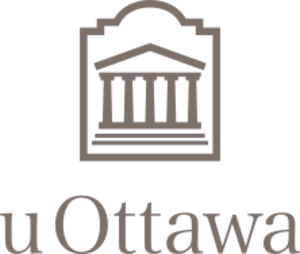 |
|||
The University of Ottawa (also called uOttawa or U of O) is a big public university in Ottawa, Ontario, Canada. It's special because it teaches in both English and French. The main campus is in the Sandy Hill neighbourhood, right next to the Rideau Canal. It covers about 42.5 hectares (which is like 105 acres)!
It started in 1848 as the College of Bytown. A bishop named Joseph-Bruno Guigues founded it. In 1861, it became the College of Ottawa. Five years later, it officially became a university. In 1965, the university became independent from religious groups.
The University of Ottawa is the biggest English-French bilingual university in the world. It offers many programs through ten main departments. These include Arts, Education, Engineering, Health Sciences, Law, Medicine, Science, Social Sciences, and the Telfer School of Management. The university's library has over 4.5 million books and other items.
This university is part of the U15 group. This means it's one of Canada's top universities for research. In 2022, it received $420 million for research projects.
The school has almost 40,000 undergraduate students and over 6,000 graduate students. About 2,300 students were in the French Immersion Studies program in 2022. Around 10,600 international students from 150 countries study here. This makes up 26% of all students. The university has over 250,000 former students, called alumni. The sports teams are known as the Gee-Gees. They compete in U Sports.
Contents
University History and Growth
The university began on September 26, 1848. It was called the College of Bytown. Bishop Joseph-Bruno Guigues founded it. The college was first in Lower Town, next to the Notre-Dame Cathedral Basilica. It moved twice before settling in Sandy Hill in 1856. Louis-Théodore Besserer donated the land for the new campus.
In 1861, the college changed its name to the College of Ottawa. This happened after the city's name changed from Bytown to Ottawa. In 1866, it officially became a university. It was the last school in Canada to get a royal charter from London. By 1872, students were earning bachelor's degrees. Master's degrees followed in 1875, and doctoral degrees in 1888.
Major Events and Changes
A big fire destroyed the main building on December 2, 1903. After the fire, a New York architect named A. O. Von Herbulis designed the new building, Tabaret Hall. It was one of the first fireproof buildings in Canada. Women were first allowed to enroll in 1919.
During World War II, the university helped with training for Canadian officers. Many students joined the Canadian Forces. In total, 1,158 students and alumni served. Sadly, 50 of them died overseas.
On July 1, 1965, the university became a public institution. It became independent from religious groups. The original religious and civil charters went to the new Saint Paul University. The University of Ottawa kept its other academic departments.
In 1970, the university bought 100 Laurier East. This building, built in 1894, became the oldest on campus. It used to be a school for young men studying for religious life. Today, it houses the university's Visual Arts department.
In 1974, the Government of Ontario made a new rule. It said the university must support bilingualism (English and French). It also had to help preserve French culture. In 1989, Dr. Wilbert Keon performed Canada's first baby artificial heart transplant at the University of Ottawa Heart Institute.
In 1998, during the university's 150th anniversary, two war memorials were unveiled. They honor the 1,000 graduates who served in conflicts. They also list the 50 who lost their lives.
Exploring the Campus
The university's main campus is in the Sandy Hill neighborhood. It's near the ByWard Market and the Rideau Canal. The main campus covers about 35.3 hectares. The university also owns other properties, making its total size 42.5 hectares. The campus moved twice before settling in its current spot in 1856.
The buildings on campus are different ages. Some are very old, like 100 Laurier (built in 1893). Others are very new, like 150 Louis-Pasteur Private (built in 2018). In 2011, the average age of buildings was 63 years. The university has 30 main buildings, many labs, and classrooms.
The main campus has two parts: Sandy Hill and Lees campus. The Lees campus was bought in 2007. It used to belong to Algonquin College. Even though it's not right next to Sandy Hill, it's considered part of the main campus. An O-Train station, uOttawa station, is right next to the campus.
University Libraries
The University of Ottawa Library has twelve locations. It holds about two million printed books and one million e-books. It also has maps, music, and more. The library's budget for new items is $15 million.
The main library is Morisset Hall. It has special collections and government information. There are five other specialized libraries. These include the Brian Dickson Law Library and the Health Sciences Library. The Morisset Library is named after Auguste-Marie Morisset, a former chief librarian.
The library also has the Learning Crossroads. This area has lecture halls and study rooms. It uses cool technology like a huge 8K screen and virtual reality equipment.
Library History
The library started when the university was founded in 1848. In 1903, a fire destroyed the main building and all the library's books. After the fire, rebuilding the library was a top priority. It received donations from governments and other countries. In 1932, the Carnegie Corporation of New York gave $1,500 to help rebuild.
Campus Museums
The University of Ottawa Museum of Classical Antiquities opened in 1975. It has ancient artifacts from 700 BC to 700 AD. These items show what daily life was like back then. The university also has Gallery 115. This is a student-run art gallery. It gives students a chance to show their art and learn about running a gallery.
Student Housing and Facilities
The university has eleven student residences. These include Leblanc Hall, Marchand Hall, and 90 University. Students can choose from different types of rooms. Some are single or double bedrooms. Others are apartment-style with multiple bedrooms. The newest residence, Annex, opened in September 2018. It has units with 1 to 5 bedrooms.
In 2019, almost 3,000 students lived on campus. Students living in residences are represented by the Residents' Association of the University of Ottawa (RAUO). This group helps improve life in residences.
The Jock Turcot University Centre (UCU) is a main hub for student life. It was finished in 1973. It has many dining options, including popular restaurant chains. The center is named after Jock Turcot, a former student leader.
Off-Campus Locations
The university has other facilities around Ottawa. The Health Science campus is in the Riverview neighborhood. It's about 7.2 hectares. This campus is mainly for the Faculty of Medicine and Health Sciences programs. It's located near The Ottawa Hospital and the Children's Hospital of Eastern Ontario. Many doctors and researchers from these hospitals teach at the university.
The Centre for Executive Leadership is in Downtown Ottawa. It's used by the Telfer School of Management for its Executive Master of Business Administration program. The university also has a small campus in Kanata. This campus helps students find jobs at technology companies there.
Sustainability Efforts
The Office of Campus Sustainability started in 2006. It works to make the university more environmentally friendly. The university signed a pledge in 2009 to become a model of environmental responsibility.
The university takes part in RecycleMania. This is a competition where schools try to recycle the most. In 2011, the University of Ottawa won first place among Canadian universities. It also ranked 14th worldwide for reducing waste.
The Free Store is another program. Students can drop off items they don't want and pick up items for free. This helps reduce waste. It's located at 647 King Edward.
On September 1, 2010, the university stopped selling bottled water on campus. This was to reduce plastic waste. The university spent $150,000 to improve water fountains.
The new Social Sciences Building, opened in 2012, is very eco-friendly. It cost $112.5 million. It has a five-story living wall made of plants. This wall helps clean the air. It's the tallest living biofilter wall in North America. The building also has a green roof and uses recycled heating. The university aims for a LEED Gold Certification for this building.
In 2006, the university started its first community garden. It has grown to over thirty pots across campus. The university also has a boreal forest and wetland environment. It's creating a living classroom for students.
The university encourages cycling with a bike share program. It offers free bike rentals and repair workshops. It also promotes car-pooling and public transit. The uOttawa and Lees O-Train stations serve the campus.
In 2011, the University of Ottawa received a silver star from the STARS program. This program measures how sustainable universities are.
How the University is Run
The university is governed by two main groups: the Board of Governors and the Senate. The Board manages the university's money and policies. It has up to 32 members, including students. The Senate sets academic policies. This includes creating new departments and setting admission standards. It has 72 members, including the president and deans.
The Chancellor is the university's honorary head. The President is the chief executive officer. They manage the academic work and daily operations. The President used to be called the "rector" until 2004.
University Money
In 2022, the university's net assets were $1.793 billion. Its revenue increased to $1,246.1 million. Most of this money comes from tuition fees and government grants. Expenses also increased to $1,160.4 million. This was mainly due to salaries, student aid, and COVID-19 costs. The university's endowment was valued at $321.3 million in 2022.
The university is a registered charity in Canada. In 2011, the university and its community brought an estimated $4.12 billion into the local economy.
Court Challenges Program
Since 2018, the University of Ottawa has hosted the Court Challenges Program (CCP). This program helps people get legal support for human rights and language rights cases. The university manages the program independently from the government.
Learning and Research
The University of Ottawa is a research university. It uses a semester system for its classes. Most students are undergraduates. In fall 2022, there were 39,770 undergraduate students and 8,128 graduate students. In 2015, the university awarded over 7,400 bachelor's degrees and many master's and doctoral degrees.
Students can also study abroad through exchange programs. The university has agreements with over 250 schools in more than 52 countries.
Bilingualism and Culture
As of 2016, the University of Ottawa was the world's largest English-French bilingual university. It has always aimed to support both languages. In 1965, a law made bilingualism an official university policy.
The university has the Official Languages and Bilingualism Institute (OLBI). This institute promotes English-French bilingualism. It also supports research in official languages. The university is part of an association that promotes French education and research.
Students don't have to be bilingual to attend. Most courses are offered in both languages. In April 2023, 30% of students used French as their main language of education. 70% used English.
Co-operative Education
The university offers a co-operative education program. This lets students get paid work experience related to their studies. It's available for both undergraduate and some graduate programs. The program started in 1980. It's now the second largest in Ontario. Over 98% of students find placements.
Students in co-op programs alternate between studying and working. Work terms can be in Canada or abroad. Many programs in arts, social sciences, engineering, science, and law offer co-op.
University Rankings
The University of Ottawa is highly ranked.
- In 2024, it was ranked 9th–12th in Canada by the Academic Ranking of World Universities.
- The 2025 QS World University Rankings placed it 9th in Canada.
- The 2025 Times Higher Education World University Rankings put it 8th in Canada.
- In the 2024–25 U.S. News & World Report Best Global University Ranking, it was 9th in Canada.
- Maclean's magazine ranked it 5th in their 2025 Medical Doctoral university rankings.
The university's graduates have a high employment rate of 97%. This shows the quality of education and research.
Research at uOttawa
The university is a member of the U15, a group of top research universities in Canada. Research is managed by the Office of the Vice-President, Research. The university has 40 research centers and institutes. These include the University of Ottawa Heart Institute.
In 2018, Research Infosource ranked Ottawa 9th among Canada's top 50 research universities. It received $324.581 million in research funding in 2017. The biggest source of funding comes from the federal government.
The university's research impact is also recognized. In 2019, it was ranked 147th globally and 8th in Canada for scientific papers. The University of Ottawa Press publishes academic books and journals.
Admission to uOttawa
Admission requirements vary for students from different places. In 2018, the average high school grade for admitted students was 85.1%. The university aims for an admission rate of at least 73%.
Students can apply for financial aid. This includes loans, grants, and scholarships from the government. In 2011–2012, the university provided $71.458 million in financial aid.
Student Life and Activities
| Undergraduate | Graduate | |
|---|---|---|
| Male | 40.6% | 44.4% |
| Female | 59.4% | 55.6% |
| Canadian student | 88.6% | 72.6% |
| International student | 11.4% | 27.4% |
The main student unions are the University of Ottawa Students' Union (UOSU) for undergraduate students. The Graduate Students' Association (GSAÉD) is for graduate students. These groups represent students on important issues.
There are over 175 student organizations and clubs. They cover interests like academics, culture, religion, and recreation. Many activities happen at the student activity center.
Two independent student newspapers are published. The Fulcrum is in English. La Rotonde is in French. The campus radio station, CHUO-FM (89.1 FM), started broadcasting in 1984.
University Athletics
Sports at the university are managed by Sports Services. Varsity teams compete in Ontario University Athletics or Réseau du sport étudiant du Québec conferences. The university has 29 competitive clubs, including 10 varsity teams.
The first athletic group formed in 1885. Garnet and grey became the official team colors. The teams are called the "Gee-Gees." This nickname comes from the initials "GG" for Garnet and Grey. A "gee gee" is also the lead horse in a race, so a horse is the mascot.
The university's teams have a rivalry with the Carleton Ravens. They compete in the Capital Hoops Classic basketball game and the Colonel By Classic ice hockey game. They also play in the Canadian football Panda Game.
The university has three athletic facilities. Montpetit Hall and Minto Sports Complex are on the main campus. Another is on Lees campus. Montpetit Hall is home to basketball and swimming teams. The Minto Sports Complex has two ice rinks. Matt Anthony Field is for soccer and rugby. In 2013, the university opened Gee-Gees Field for its football team. This stadium holds over 4,000 spectators.
Famous People from uOttawa
Many graduates have become successful in different fields. As of October 2011, the university had 167,224 alumni. Faculty and graduates have won awards like the Governor General's Awards and the Pulitzer Prize for Fiction. Famous alumni include Pulitzer Prize winner Carol Shields.
Several Chancellors of the university have been important figures. This includes Michaëlle Jean, who was the 27th Governor General of Canada. Many alumni have also worked in government. Four have been heads of government, including Paul Martin, the 24th Prime Minister of Canada. The 36th Argentine Vice President, Gabriela Michetti, also studied here.
Important business leaders include Daniel Lamarre, former CEO of Cirque du Soleil. Calin Rovinescu was president and CEO of Air Canada. Alex Trebek, the host of Jeopardy!, is also an alumnus. A building on campus is named after him. Dafydd Williams, a Canadian astronaut, graduated from the medical school.
University Symbols
The university's coat of arms was granted on June 5, 1990. It features a red shield with smaller white shields. On a white band, there are two open books. One book has a rose, and the other has a fleur-de-lys. The crest shows trillium flowers and fleurs-de-lys around a temple. The motto is "Deus Scientiarum Dominus Est," which means "God Is The Master Of The Sciences."
More to Explore
- Higher education in Ontario
- List of Canadian universities by endowment
- List of schools in Ottawa
- List of universities in Ontario
See also
 In Spanish: Universidad de Ottawa para niños
In Spanish: Universidad de Ottawa para niños


